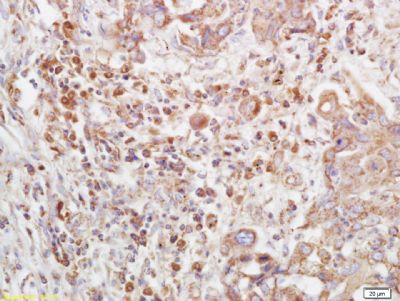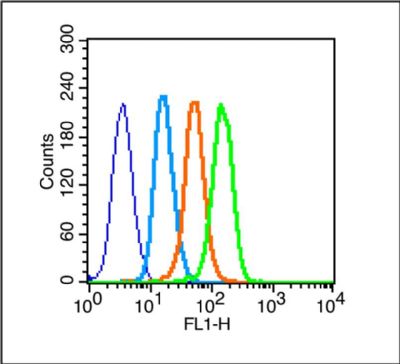产品中心
当前位置:首页>产品中心Anti-phospho-ATM(Ser1981)
货号: bs-2272R 基本售价: 1580.0 元 规格: 100ul
产品信息
- 产品编号
- bs-2272R
- 英文名称
- phospho-ATM (Ser1981)
- 中文名称
- 磷酸化毛细血管扩张性共济失调症突变蛋白抗体
- 别 名
- ATM(Phospho-Ser1981); ATM (phospho S1981); AT complementation group A; AT complementation group C; AT complementation group D; AT complementation group E; AT mutated; AT protein;AT1;ATA;Ataxia telangiectasia gene mutated in human beings; Ataxia telangiectasia mutated; ATC; ATDC; ATE; ATM; Human phosphatidylinositol 3 kinase homolog; Serine protein kinase ATM; T cell prolymphocytic leukemia; TEL1; TPLL.
- 规格价格
- 100ul/1580元购买 大包装/询价
- 说 明 书
- 100ul
- 产品类型
- 磷酸化抗体
- 研究领域
- 信号转导 细胞凋亡 细胞周期蛋白 激酶和磷酸酶
- 抗体来源
- Rabbit
- 克隆类型
- Polyclonal
- 交叉反应
- Human, Mouse, Rat,
- 产品应用
- ELISA=1:500-1000 IHC-P=1:400-800 IHC-F=1:400-800 Flow-Cyt=1μg /test IF=1:100-500 (石蜡切片需做抗原修复)
not yet tested in other applications.
optimal dilutions/concentrations should be determined by the end user.
- 分 子 量
- 370kDa
- 细胞定位
- 细胞核 细胞浆
- 性 状
- Lyophilized or Liquid
- 浓 度
- 1mg/ml
- 免 疫 原
- KLH conjugated Synthesised phosphopeptide derived from human ATM around the phosphorylation site of Ser1981:EG(p-S)QS
- 亚 型
- IgG
- 纯化方法
- affinity purified by Protein A
- 储 存 液
- 0.01M TBS(pH7.4) with 1% BSA, 0.03% Proclin300 and 50% Glycerol.
- 保存条件
- Store at -20 °C for one year. Avoid repeated freeze/thaw cycles. The lyophilized antibody is stable at room temperature for at least one month and for greater than a year when kept at -20°C. When reconstituted in sterile pH 7.4 0.01M PBS or diluent of antibody the antibody is stable for at least two weeks at 2-4 °C.
- PubMed
- PubMed
- 产品介绍
- background:
ATM is a 370 kDa nuclear phosphoprotein involved in the autosomal recessive disease Ataxia Telangiectasia (AT). ATM belongs to a novel family of proteins associated with cell cycle regulation, apoptosis, and response to DNA damage repair (DNA damage caused by such things as ionizing irradiation activates ATM kinase). The C terminal region has extensive homology to the catalytic domains of Phosphatidylinositol 3 kinases (PI3 kinases).
Subcellular Location:
Nucleus. Cytoplasmic vesicle. Primarily nuclear. Found also in endocytic vesicles in association with beta-adaptin.
Tissue Specificity:
Found in pancreas, kidney, skeletal muscle, liver, lung, placenta, brain, heart, spleen, thymus, testis, ovary, small intestine, colon and leukocytes.
Post-translational modifications:
Phosphorylated by NUAK1/ARK5. Autophosphorylation on Ser-367, Ser-1893, Ser-1981 correlates with DNA damage-mediated activation of the kinase.
Acetylation, on DNA damage, is required for activation of the kinase activity, dimer-monomer transition, and subsequent autophosphorylation on Ser-1981. Acetylated in vitro by KAT5/TIP60.
DISEASE:
Defects in ATM are the cause of ataxia telangiectasia (AT) [MIM:208900]; also known as Louis-Bar syndrome, which includes four complementation groups: A, C, D and E. This rare recessive disorder is characterized by progressive cerebellar ataxia, dilation of the blood vessels in the conjunctiva and eyeballs, immunodeficiency, growth retardation and sexual immaturity. AT patients have a strong predisposition to cancer; about 30% of patients develop tumors, particularly lymphomas and leukemias. Cells from affected individuals are highly sensitive to damage by ionizing radiation and resistant to inhibition of DNA synthesis following irradiation.
Note=Defects in ATM contribute to T-cell acute lymphoblastic leukemia (TALL) and T-prolymphocytic leukemia (TPLL). TPLL is characterized by a high white blood cell count, with a predominance of prolymphocytes, marked splenomegaly, lymphadenopathy, skin lesions and serous effusion. The clinical course is highly aggressive, with poor response to chemotherapy and short survival time. TPLL occurs both in adults as a sporadic disease and in younger AT patients.
Note=Defects in ATM contribute to B-cell non-Hodgkin lymphomas (BNHL), including mantle cell lymphoma (MCL).
Note=Defects in ATM contribute to B-cell chronic lymphocytic leukemia (BCLL). BCLL is the commonest form of leukemia in the elderly. It is characterized by the accumulation of mature CD5+ B lymphocytes, lymphadenopathy, immunodeficiency and bone marrow failure.
Similarity:
Belongs to the PI3/PI4-kinase family. ATM subfamily.
Contains 1 FAT domain.
Contains 1 FATC domain.
Contains 1 PI3K/PI4K domain.
SWISS:
Q13315
Gene ID:
472
Database links:Entrez Gene: 472 Human
Entrez Gene: 11920 Mouse
Entrez Gene: 300711 Rat
Omim: 607585 Human
SwissProt: Q13315 Human
SwissProt: Q62388 Mouse
SwissProt: P17764 Rat
Unigene: 367437 Human
Unigene: 5088 Mouse
Unigene: 214048 Rat
Important Note:
This product as supplied is intended for research use only, not for use in human, therapeutic or diagnostic applications.
- 产品图片
 Tissue/cell: human lung carcinoma; 4% Paraformaldehyde-fixed and paraffin-embedded;
Tissue/cell: human lung carcinoma; 4% Paraformaldehyde-fixed and paraffin-embedded;
Antigen retrieval: citrate buffer ( 0.01M, pH 6.0 ), Boiling bathing for 15min; Block endogenous peroxidase by 3% Hydrogen peroxide for 30min; Blocking buffer (normal goat serum,C-0005) at 37℃ for 20 min;
Incubation: Anti-phospho-ATM(Ser1981) Polyclonal Antibody, Unconjugated(bs-2272R) 1:200, overnight at 4°C, followed by conjugation to the secondary antibody(SP-0023) and DAB(C-0010) staining Blank control (blue line): Hela (fixed with 2% paraformaldehyde (10 min) , then permeabilized with 90% ice-cold methanol for 20 min on ice).
Blank control (blue line): Hela (fixed with 2% paraformaldehyde (10 min) , then permeabilized with 90% ice-cold methanol for 20 min on ice).
Primary Antibody (green line): Rabbit Anti- phospho-ATM(Ser1981) antibody (bs-2272R),Dilution: 1μg /10^6 cells;
Isotype Control Antibody (orange line): Rabbit IgG .
Secondary Antibody (white blue line): Goat anti-rabbit IgG-FITC,Dilution: 1μg /test.

